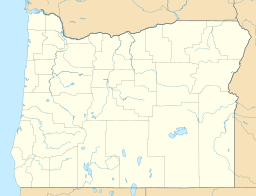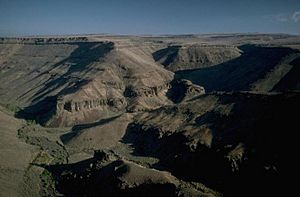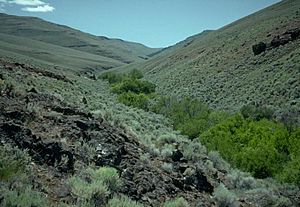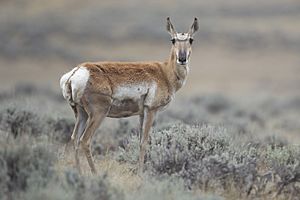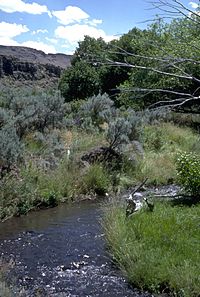Trout Creek Mountains facts for kids
Quick facts for kids Trout Creek Mountains |
|
|---|---|
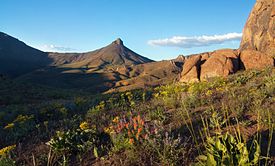
Disaster Peak and spring wildflowers in 2013
|
|
| Highest point | |
| Peak | Orevada View Benchmark |
| Elevation | 8,506 ft (2,593 m) |
| Dimensions | |
| Length | 51 mi (82 km) north–south |
| Width | 36 mi (58 km) west–east |
| Area | 811 sq mi (2,100 km2) |
| Geography | |
| Country | United States |
| Range coordinates | 42°06′0″N 118°17′34″W / 42.10000°N 118.29278°W |
| Geology | |
| Age of rock | Triassic, Cretaceous and Miocene epoch |
| Type of rock | Volcanic; uplifted and faulted |
The Trout Creek Mountains are a group of mountains in a quiet, dry area of the Great Basin. Most of them are in southeastern Oregon, and a small part is in northern Nevada. The highest point is Orevada View Benchmark, which is 8,506 feet (2,593 meters) above sea level. Another important peak is Disaster Peak, which is 7,781 feet (2,372 meters) high.
These mountains are like many others in the Great Basin. They have long, parallel mountain ranges with flat valleys in between. The Trout Creek Mountains mostly run north to south. They are made of large blocks of rock that have been pushed up and tilted. Much of the rock is basalt, which came from an ancient volcano. Underneath this basalt are older, changed rocks. The southern part of the mountains has many granite rocks sticking out. The land has rolling hills and ridges, with steep cliffs and deep canyons.
Most of these mountains are public land, managed by the Bureau of Land Management (BLM). Not many people live or work here. The main activity is raising cattle. In the past, mines in the McDermitt Caldera produced a lot of mercury. People can visit the mountains for fun, but they are not often crowded. Plants like big sagebrush and desert grasses grow here. You can also find cottonwood and alder trees near water. Birds like sage grouse and mountain chickadee live here. Common mammals include pronghorn and jackrabbits.
Even though the area is dry, a few streams flow all year. These streams are home to a special fish called the Lahontan cutthroat trout. In the 1900s, the number of these fish went down. This was partly because cattle grazing damaged the areas along the streams. In the 1980s, people started to disagree about how the land should be used. To solve this, a group called the Trout Creek Mountain Working Group was formed in 1988. This group helped ranchers, environmentalists, and government groups work together. They agreed on new ways to use the land. Since the early 1990s, the areas along the streams have started to get better.
Contents
Exploring the Trout Creek Mountains
The Trout Creek Mountains are in a very remote part of southeastern Oregon and northern Nevada. They are in Harney and Humboldt counties. The closest small towns are Fields, Oregon, Denio, Nevada, and McDermitt. The mountains are about 150 miles (240 km) southwest of Boise, Idaho. They are also about 190 miles (310 km) northeast of Reno, Nevada.
The mountains and the flat areas around them cover about 811 square miles (2,100 km²). The range is about 51 miles (82 km) long from north to south. It is about 36 miles (58 km) wide from east to west. Most of the mountains (78%) are in Oregon, and 22% are in Nevada. The highest point is Orevada View Benchmark, which is 8,506 feet (2,593 meters) high. It is in Nevada, about one mile south of the Oregon border. Disaster Peak is about two miles southeast of Orevada View. It is a large, round mountain that you can see from far away. Disaster Peak is 7,781 feet (2,372 meters) high. It is part of a smaller mountain group called The Granites.
The land in the Trout Creek Mountains changes a lot. There are wide, flat areas and rolling hills. There are also high, rocky cliffs cut by deep canyons. These canyons have steep sides with loose rocks at the bottom. You can find green meadows around springs. However, most streams in the mountains do not flow all year. Big streams that flow north from the mountains include Cottonwood Creek, Trout Creek, Willow Creek, and Whitehorse Creek. These streams flow into areas where the water does not reach the ocean. Trout Creek and Whitehorse Creek are the largest. The Kings River and McDermitt Creek drain the southern parts of the mountains.
How the Mountains Were Formed
The Trout Creek Mountains are part of the Basin and Range Province in the Western United States. This area has many long mountain ranges that run north to south, separated by wide, dry valleys. The Trout Creek Mountains are blocks of land that were pushed up and tilted. They have steep cliffs on their southern and eastern sides. The southern part, called The Granites, has many Cretaceous-age granite rocks. These granite rocks are often found in the valleys below the volcanic ridges.
The Trout Creek Mountains are mostly made of basalt rock. This basalt came from a shield volcano that used to be where Steens Mountain is today. About 17 million years ago, during the Miocene epoch, lava flowed from this volcano and other vents. These lava flows spread across the land that is now the Trout Creek Mountains. The eruptions from the Steens volcano lasted for about one million years. There were at least 70 different lava flows. Underneath this basalt rock are much older, changed rocks. These older rocks might be connected to some Triassic-age rocks in the Blue Mountains of northeastern Oregon.
A big feature in the Trout Creek Mountains is the McDermitt Caldera. A caldera is a large bowl-shaped hole formed when a volcano collapses. This oval-shaped caldera is on the border between Oregon and Nevada, on the eastern side of the mountains. It is about 28 miles (45 km) long and 22 miles (35 km) wide. The caldera formed about 16 million years ago when a lava dome collapsed after volcanic eruptions. This area has many valuable ore deposits. Mercury and uranium have been mined here. Other ores like antimony, cesium, and lithium were also mined.
Weather in the Mountains
The Trout Creek Mountains have a semi-arid (partly dry) climate. This is because they are in the "rain shadow" of mountains to the west. When moist air from the Pacific Ocean moves east, most of the rain falls on the coastal mountains and the Cascade Range. By the time the air reaches the Trout Creek Mountains, it is much drier.
Because of this, the mountains get only about 8 to 26 inches (200 to 660 mm) of rain each year. Most areas get between 8 and 12 inches (200 and 300 mm). A lot of the rain falls between March and June. The rest falls as snow in the fall and winter. Snow below 6,000 feet (1,800 meters) usually melts by April. But at higher elevations, snow can stay until mid-June. When the snow melts in spring, it can sometimes cause local floods.
| Climate data for the Whitehorse Ranch, Oregon (along lower Whitehorse Creek, north of the Trout Creek Mountains) | |||||||||||||
|---|---|---|---|---|---|---|---|---|---|---|---|---|---|
| Month | Jan | Feb | Mar | Apr | May | Jun | Jul | Aug | Sep | Oct | Nov | Dec | Year |
| Mean daily maximum °F (°C) | 41.4 (5.2) |
46.8 (8.2) |
54.2 (12.3) |
61.0 (16.1) |
68.8 (20.4) |
77.4 (25.2) |
87.6 (30.9) |
86.5 (30.3) |
77.8 (25.4) |
65.7 (18.7) |
51.0 (10.6) |
40.8 (4.9) |
63.3 (17.3) |
| Daily mean °F (°C) | 31.2 (−0.4) |
35.2 (1.8) |
41.4 (5.2) |
47.1 (8.4) |
54.4 (12.4) |
61.7 (16.5) |
71.0 (21.7) |
69.5 (20.8) |
60.8 (16.0) |
50.5 (10.3) |
38.7 (3.7) |
30.2 (−1.0) |
49.3 (9.6) |
| Mean daily minimum °F (°C) | 20.9 (−6.2) |
23.5 (−4.7) |
28.6 (−1.9) |
33.2 (0.7) |
40.0 (4.4) |
46.0 (7.8) |
54.3 (12.4) |
52.5 (11.4) |
43.8 (6.6) |
35.3 (1.8) |
26.5 (−3.1) |
19.7 (−6.8) |
35.4 (1.9) |
| Average precipitation inches (mm) | 0.63 (16) |
0.70 (18) |
0.87 (22) |
0.92 (23) |
0.93 (24) |
0.55 (14) |
0.21 (5.3) |
0.68 (17) |
0.54 (14) |
0.57 (14) |
0.67 (17) |
0.71 (18) |
7.98 (202.3) |
| Source: National Oceanic and Atmospheric Administration, National Climatic Data Center normals data, 1981–2010 | |||||||||||||
The winds usually blow from the west-southwest. They are strongest in March and April. Short, strong thunderstorms are common from April to October. Summer thunderstorms are often isolated and can produce lightning without rain.
Plants and Animals of the Mountains
Plant Life (Flora)
The plants in the Trout Creek Mountains are mostly big sagebrush and desert grasses. Other common shrubs include bitterbrush and snowberry. You can also find patches of mountain mahogany. Common grasses include Idaho fescue and bluebunch wheatgrass.
Less than one percent of the mountains has wet meadows and riparian greenways. These are areas with plants along stream banks. But these areas are very important for the local ecosystem. The meadows are around springs and are usually small. Narrow greenways follow the streams that flow all year. Many greenway areas have quaking aspen and willow trees. Cottonwood and alder trees grow at lower elevations where the land is flatter.
For many years, heavy cattle grazing in some parts of the mountains caused problems. It led to a loss of some grasses, stream-side plants, and young aspen and willow trees. This damage started to be fixed in the early 1970s. Plans to reduce grazing were put in place in the 1980s and early 1990s. However, large wildfires in 2012 burned much of the plants, harming these important stream areas.
Animal Life (Fauna)
Animals in the Trout Creek Mountains are used to living in the High Desert environment. Pronghorn are often seen in the open, sagebrush areas. Mule deer live in the cottonwood and willow groves. You can also find bighorn sheep, cougars, and bobcats in the higher parts. Jackrabbits and coyotes are common everywhere. Mustangs sometimes travel through the mountains. Other mammals include the northern pocket gopher and Belding's ground squirrel. North American beavers live in and near streams.
Many bird species live here, such as the sage grouse, mountain chickadee, and gray-headed junco. You can also see different kinds of ravens and eagles.
Several streams in the Trout Creek Mountains are home to trout. This includes the rare Lahontan cutthroat trout. These fish live in small, separate groups, often in just one stream. Because they have been separated for so long, these groups have important genetic differences. For most of the 1900s, the number of these trout went down a lot. It was listed as an endangered species in 1970 and then as threatened in 1975.
The fish numbers dropped for several reasons. Cattle grazing damaged their homes along the streams. There were also droughts, too much fishing, and competition with other fish. Also, hybridization with rainbow trout meant fewer pure Lahontan cutthroat trout. But since the 1980s, less cattle grazing in stream areas has helped the fish's home and numbers start to recover.
How People Use the Mountains
The Bureau of Land Management (BLM) manages most of the land in the Trout Creek Mountains. There are also some private lands, mainly used for ranching along mountain streams. The BLM lands include large areas where local ranchers can graze their cattle.
People have recorded over 100 mining claims in the mountains since 1892. Some were for gold. Commercial mining has happened in some areas, mostly near the McDermitt Caldera. Here, uranium and large amounts of mercury were taken out. Mines in the Opalite Mining District produced 270,000 flasks of mercury. This was "the richest supply of mercury in the western hemisphere" in the 1900s. The Cordero and McDermitt mines were the two biggest mercury mines in North America. They operated from 1933 to 1989. The McDermitt Mine closed in 1992, being the last mercury mine in the United States.
The entire mountain range is very remote. Because of this, few people visit, and it feels like a true wilderness. Camping, hunting, fishing, and hiking are the most popular activities. The only developed recreation spot nearby is Willow Creek Hot Springs. There are also miles of trails for four-wheel off-road vehicles. Hunters come for mule deer, pronghorn, chukars, and rabbits. Fishing on some streams is sometimes allowed on a catch-and-release basis. The mountains are also great for hiking off-trail or on animal paths along canyons and creek bottoms. Over 100 old sites show that Northern Paiute people used the area as far back as 7,000 years ago.
Cattle grazing in the Trout Creek Mountains started in the late 1800s. The BLM now manages grazing permits in the area. Cattle can be seen grazing in some areas during spring and summer. In the 1980s, there was a disagreement about how grazing affected the local environment.
Working Together to Protect the Land
By the 1970s and 1980s, a century of heavy cattle grazing had damaged many of the plants along stream banks in the Trout Creek Mountains. This caused stream banks to wear away, and plants from drier areas started to grow into the wet stream zones. Aspen trees also decreased because grazing cattle ate the young trees. This meant less shade over streams, making the water warmer. These conditions put the rare Lahontan cutthroat trout at risk. Since the Lahontan trout was listed as a threatened species, environmental groups wanted to stop grazing in the Trout Creek Mountains.
Starting in the early 1970s, the Bureau of Land Management (BLM) found damaged stream areas. They began projects to fix these natural homes. About 20,000 willow trees were planted along streams. Small dams were built to create more pools in the streams. Fences were added to protect stream areas from grazing. Next, the BLM wanted to change land-use plans to improve grazing practices. This became a difficult and debated project.
Environmentalists pushed the BLM to close much of the Trout Creek Mountains to grazing. Ranchers felt frustrated and joined the Sagebrush Rebellion to protect their grazing rights. At first, it seemed like the grazing issue would lead to long legal battles. However, in 1988, groups representing all sides of the issue came together. They formed the Trout Creek Mountain Working Group. The group's goal was to find a solution that everyone could agree on. This plan would protect the land's health and also help ranchers' businesses.
The first members of the Trout Creek Mountain Working Group included:
- Oregon Cattlemen's Association
- Whitehorse Ranch (the largest ranch in the area)
- Disaster Peak Ranch
- McCormick Ranch
- Zimmerman Ranch
- Wilkinson Ranches
- Oregon Environmental Council
- Oregon Trout
- Izaak Walton League
- Oregon State University
- Oregon Department of Fish and Wildlife
- United States Fish and Wildlife Service
- Bureau of Land Management
For several years, the group met to discuss ways to restore the land while supporting local ranchers. All meetings were open to the public.
The group finally agreed on a grazing plan. This plan helped both the environment of sensitive stream areas and the ranchers' economic needs. In 1989, the Whitehorse Ranch agreed to let two grazing areas rest. These areas covered 50,000 acres (20,000 ha). This was to help stream greenways and mountain pastures recover. The ranch's area on Fifteen Mile Creek rested for three years. Its Willow Creek pasture rested for five years before grazing started again. Also, the grazing season in mountain pastures was shortened from four months to two. The total number of cattle allowed in these areas was reduced from 3,800 to 2,200. Finally, sensitive areas were fenced off to protect them from cattle. New water sources were built away from streams. Other ranches also agreed to rest specific pastures.
In 1991, the Bureau of Land Management approved a new grazing plan. It was based on the agreements made by the Trout Creek Mountain Working Group. The plan started in 1992. Since then, plants in the stream areas of the Trout Creek Mountains have recovered. Studies by the United States Fish and Wildlife Service show that the Lahontan cutthroat trout population is also recovering. It is still listed as threatened.
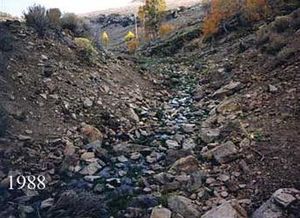 |
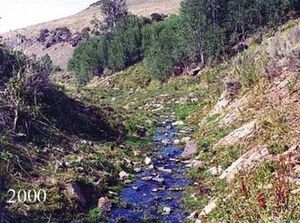 |
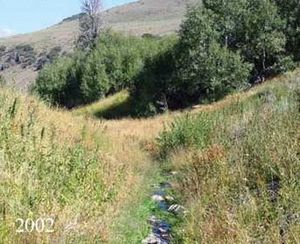 |
| Cottonwood Creek riparian area before restoration, 1988 | Cottonwood Creek riparian area during recovery, 2000 | Cottonwood Creek riparian area after restoration, 2002 |
See also
 In Spanish: Montañas Trout Creek para niños
In Spanish: Montañas Trout Creek para niños


